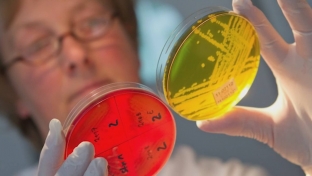The problem of atopic dermatitis is of great importance in medicine, as the prevalence of the disease is growing every year. Atopic dermatitis is a multifactorial disease, the development of which is associated with genetic defects in the immune response. It is known that not all people are prone to atopic dermatitis.
A significant risk factor for the development of the disease is intestinal dysbacteriosis, which is determined in 95% of patients with atopic dermatitis. No wonder it is believed that the root of the immune system disorder is in the disruption of the work and composition of the intestinal microflora.
Intestinal dysbacteriosis – main cause of atopic dermatitis
In confirmation of the significant role of intestinal dysbacteriosis, clinical cases can be cited when a relationship was observed between the severity of dysbacteriosis and the clinical manifestations of atopic dermatitis.
The main factors in the development of intestinal dysbacteriosis and manifestations of atopic dermatitis:
- depriving a newborn of breast milk from the first days of life;
- early transition to artificial nutrition;
- early introduction of complementary foods;
- medication use;
- vaccination;
- Wide use of household chemicals.
An increase in the incidence of atopic dermatitis is observed in the neonatal period, which has an explanation. After all, the occurrence of allergic reactions and the development of intestinal dysbacteriosis are facilitated by the same mechanisms and factors.
Composition of normal intestinal microflora. The role of bifidobacteria
The mass of all microorganisms that live in the intestines is about two kilograms. Read more about the functions of bacteria in the intestines at estet-portal.com. Normally, the microflora is 95% anaerobic bacteria, among which the main place is occupied by bifidobacteria and lactobacilli. Aerobic bacteria are represented by Escherichia coli and make up the rest of the flora. The most indispensable and necessary for the intestines are bifidobacteria.

The role of bifidobacteria is to stimulate peristalsis, decompose carcinogens, produce vitamins, and also increase immunity. The waste products of bifidobacteria are lactic, formic, acetic acids, succinic acid, amino acids and proteins, vitamins B1, B2, vitamin K, pantothenic and nicotinic acids, folic acid, cyanocobalamin and pyridoxine.
With a decrease in the number of bifidobacteria, in addition to intestinal dysbacteriosis, a deficiency of the above substances develops. Also, bifidobacteria are biological sorbents and are capable of accumulating heavy metal compounds, formaldehydes, phenols and other toxic substances, and in large quantities.
The role of lactobacilli for the body. The concept of "intestinal dysbacteriosis"
Lactobacilli are the first to colonize the body of a newborn baby in the early postnatal period.
Lack or absence of lactobacilli is the main cause of atopic dermatitis in children. Therefore, lactobacilli are a link in the pathogenesis of "atopic dermatitis - dysbacteriosis".
Lactobacilli synthesize immunoglobulin A, which neutralizes food allergens and reduces their absorption in the intestine. In the international classification, there is no such disease as intestinal dysbacteriosis. The term "bacterial overgrowth syndrome" is used. Intestinal dysbacteriosis is not an independent disease, but only a microbiological manifestation of gastrointestinal pathologies.
Thus, the presence of gastrointestinal pathologies, which are manifested by intestinal dysbacteriosis, is the main cause of the development of atopic dermatitis. And proper nutrition of a nursing mother and long-term breastfeeding can significantly reduce the likelihood of developing intestinal dysbacteriosis and atopic dermatitis in a child.







Add a comment